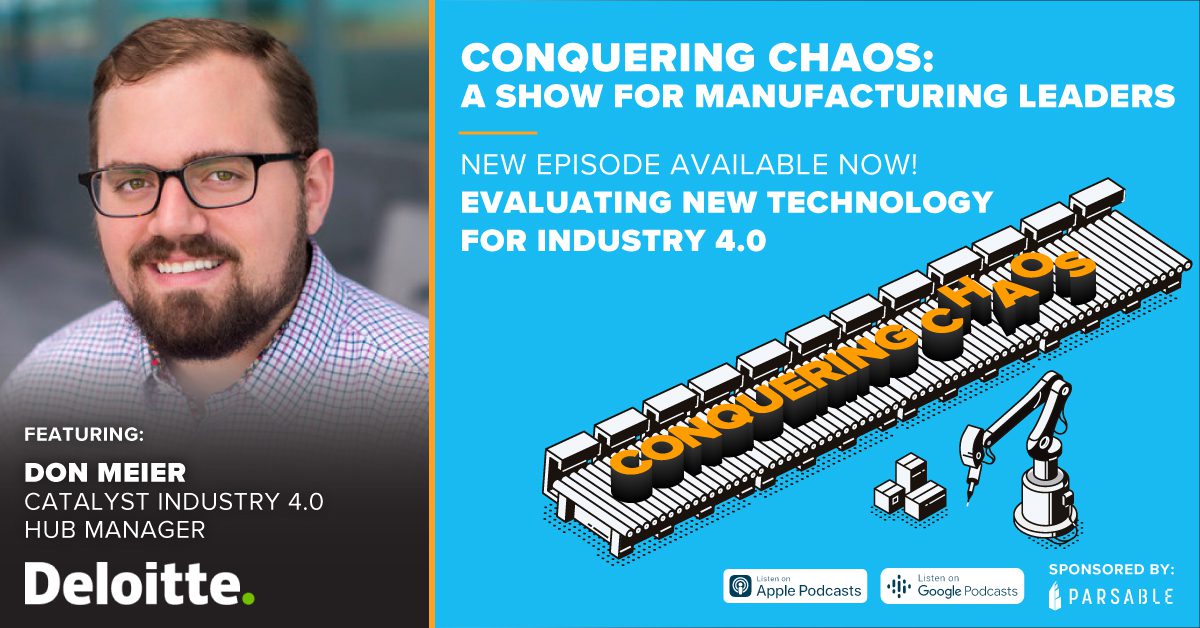Technology Can Support Your Manufacturing Operations

With new technology introduced everyday, how do you determine what fits best to support your daily manufacturing operations?
In our latest episode of “Conquering Chaos: A Show for Manufacturing Leaders,” Parsable’s connected work expert and podcast host, Josh Santo, chats with Don Meier, Deloitte’s Catalyst Innovation Manager, about evaluating new technology and the role it plays in your digital transformation and Industry 4.0 efforts.
In his day-to-day, Meier is constantly focused on these burning questions: how are we thinking about the technology innovation landscape? How are we thinking about how to bring that landscape together in the form of an ecosystem? And also, how can we go out and test new solutions, whether that’s bringing together ecosystem partners, building a new solution or doing something else innovative in the space?
Listen to the full podcast episode here.
Identifying Problems That Need To Be Solved
According to Meier, Deloitte’s Catalyst Innovation team isn’t just centered around technology. The organization is rooted in being “problem-centric,” focusing on things they know that if they solve will have a lasting impact. It’s not about making up problems for technology to solve, but identifying existing problems that need to be solved and identifying emerging technology that can help solve those issues. After identifying both the problem and solution, the next step is to strategize how to apply the technology, making sure it’s viable and can continuously make an impact.
The Role of Industry 4.0 and Digital Transformation
There are many differing, and sometimes conflicting, opinions about what digital transformation looks like. One thing is clear – the path to digital transformation involves both strategy and technology. When making the connection between digital transformation and Industry 4.0, Meier explains that he thinks of both as the transformation of companies that make things. The question to consider in relation to digital transformation is how can manufacturers not only digitize the actual operations that are taking place, but also the top-line revenue growth? How can technology provide insights into your operations at a lower cost, but also create net new revenue streams based on this now digitized data that’s created?
Achieving Bottom-Line and Top-Line Growth by Transforming Operations
Technology impacts bottom-line growth, providing an opportunity for operational efficiency to be improved. Whether that’s through better communication with workers, a connected worker platform such as Parsable, or having the ability to leverage sensor data to understand you operations in detail. That’s going to increase utilization, throughput and overall equipment effectiveness (OEE).
When thinking about the top-line space, there’s also a great deal of untapped potential in the future of Industry 4.0. There’s revenue growth potential that comes from new innovations, like 3D printing, and the opportunities that are opened up by that. It’s an incredible aperture of opportunity, both on the revenue and cost side.
Exploring New Ways of Doing Things
Companies need to avoid the idea that “this is the way we do it” and begin exploring whether more efficient and effective ways of doing things exist or could be made easier – especially with new emerging technology. For example, when a machine goes down a frontline worker might have to walk half a mile across the shop floor to notify someone that the machine is down and a mechanic is needed. And then identify if that specific mechanic can work on the machine. With the help of technology, there are easier ways to handle this process more efficiently moving forward.
The Question of Build vs. Buy
Build versus buy is a common question that comes up. Meier mentions it’s part of the process when his team is evaluating the ecosystem, and how they can bring everything together. There’s a constant analysis of whether it makes sense, even within Deloitte, to build out a capability, whether that’s with human capital or actually doing it in a more automated fashion with software. It’s important to think about how difficult it is to actually build and whether the solution can be built for scale. Additionally, it’s important not to make the decision without having some real-life examples first. If you’re interested in learning more, listen to the full podcast episode.






